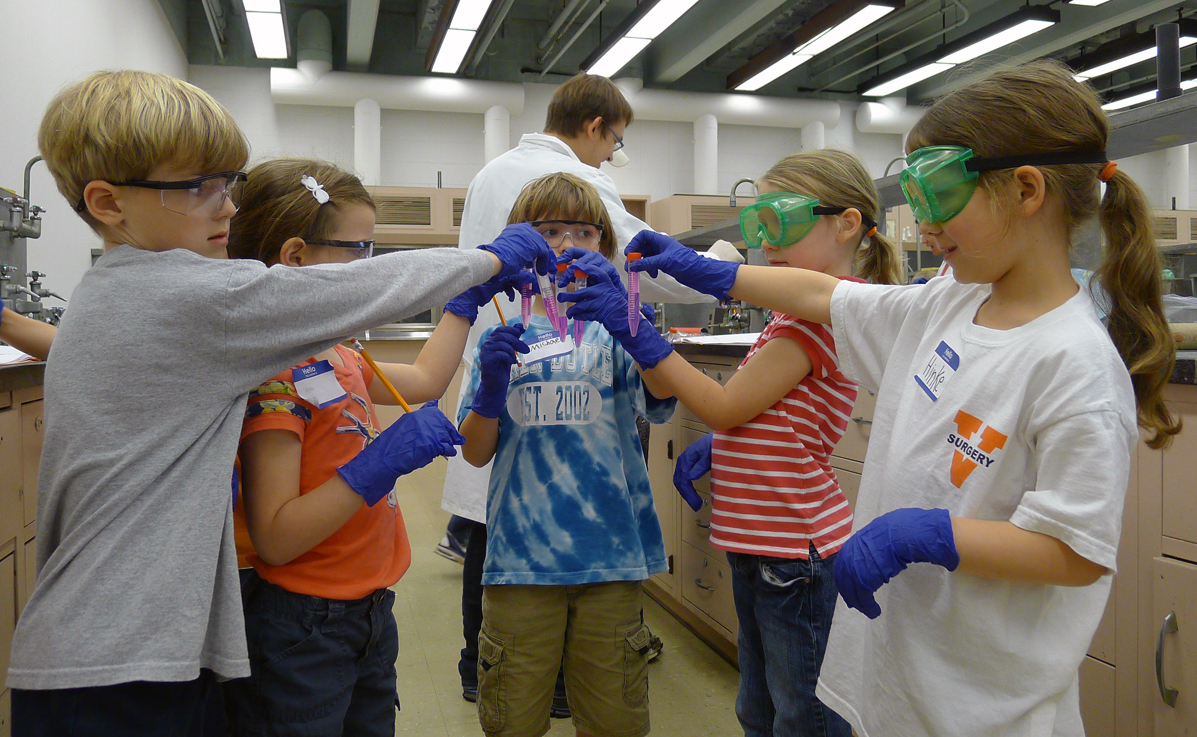A group of chemistry students from the University of Virginia's Graduate School of Arts & Sciences goes into an elementary school classroom and poses a very important question:
A pirate has gone on a sea voyage and comes home with scurvy. Which juice should he bring with him next time to prevent getting this illness?
To find the answer, the students first must learn what scurvy is (a disease causing "weakness, swollen joints, muscle hardness, gum problems, tooth loss, and slow healing of wounds, " according to WebMD) and what prevents it. Then they must find the juice containing the highest concentration of vitamin C through a process called "vitamin C titration."
This is one of many experiments a group of graduate chemistry students known as Learning through Experiments, Awareness and Demonstrations, or LEAD, has designed to help make learning science fun from an early age.
"It's more about the spark, that they can do something with the physical world," said LEAD president Trisha Vickrey, a fifth-year Ph.D. student who helped create the group while pursuing a degree in electroanalytical chemistry on biological applications.
"The physical world has rules and there are things that they can understand," she said. "I think that getting their hands dirty doing the science makes the difference."
One of the demonstrations LEAD presents to students is called "Elephant's Toothpaste." Joseph Houck, vice president of LEAD and a fourth-year Ph.D. student in medicinal chemistry, explained that in this experiment, hydrogen peroxide reacts with potassium iodide in a large graduated cylinder and decomposes, releasing oxygen in bubbles and moving food coloring up the column of the cylinder, which "ends up looking like a big thing of Aquafresh for an elephant," Vickrey said. The demonstration shows how two chemicals combine to form a new chemical, or in this case, water and oxygen.
Houck said that by exploring scientific inquiry, "Students get the agency of being a scientist."
Other popular experiments include the "Fireworks and Milk Experiment," in which soap pulls food coloring through different containers of milk at different rates in beautiful firework-like designs, depending on the fat content of the milk. Another crowd favorite is "Penny the Pony," in which students must use chromatography of ink pens and soil analysis to conduct a forensic investigation of who kidnapped Penny.
"We kind of come up with something new every month. It's pretty diverse," Vickrey said.
One of LEAD's goals, Vickrey said, is to expand young students' perceptions of scientists to include people of all ages, genders and cultural backgrounds.
"We're all scientists. They can see us as role models. They can get exposure to people they want to be like," she said.
The group – which draws from a 20-person listserv of mostly graduate, and some undergraduate students in chemistry – takes about five members once a week to visit area schools to teach science lessons of their own creation. Vickrey noted that this year the group visited more than 80 classrooms, and since 2009, has taught at least 7,500 students.
The group also volunteers monthly at the Discovery Museum on Charlottesville's Downtown Mall.
"It's nice to feel like you're in a community, a salient part of it, making a difference," Vickrey said. "We're a pretty philanthropic graduate student body and department in general."
Jill Venton, an associate professor of chemistry and faculty adviser for the group, praised the graduate students for not only coming up with the lesson plans, but also aligning them with Virginia's Standards of Learning.
"I think that's really made them successful – that teachers want them to come in to help with the curriculum," Venton said. Many elementary school teachers have little time for extra lessons and are often intimidated by science as a subject, so by bringing lessons to the class that fit in with the learning objectives for the year, LEAD provides a service to the teachers, she said.
In March, Venton helped LEAD plan its first-ever Chemistry Camp, which brought 77 students from kindergarten to the fourth grade to the Chemistry Building for five hours on a Saturday. Over the course of the day, the students rotated through five experiments, a group lunch and a 45-minute closing demonstration.
"I think it was really well-planned and executed and the students just did a really good job with it," Venton said. "We had really great feedback from parents."
LEAD has visited Meriwether Lewis Elementary School twice to teach whole grades of about 70 kids. Anne Straume, a third-grade teacher at the school, told the student leaders in an email after their second visit, "Thanks for the wonderful presentation yet again today! You folks are always so prepared and come with the most interesting investigations. This is such a gold mine for our students. I'm very impressed with the amount of time you are able to donate."
While LEAD receives some financial support from the department, as well as use of lab equipment and bench space in the Physical and Life Sciences Research Building, the students in LEAD raise a lot of their own funds. For example, the Chemistry Camp acted as both an outreach effort and a fundraiser. LEAD’s leaders hope to use its funds to expand their future efforts.
LEAD will continue to visit area schools, including Meriwether Lewis Elementary in Albemarle County, in June and will teach at the Slimy Science Summer Workshop at Amazement Square in Lynchburg, VA on June 5 and July 3. They will present their outreach program and chemistry camp model at a public outreach symposium as part of the American Chemical Society National Meeting in August.'
— by Kate Colwell
Media Contact
Article Information
May 10, 2012
/content/good-chemistry-grad-students-design-engaging-elementary-school-science-lessons

